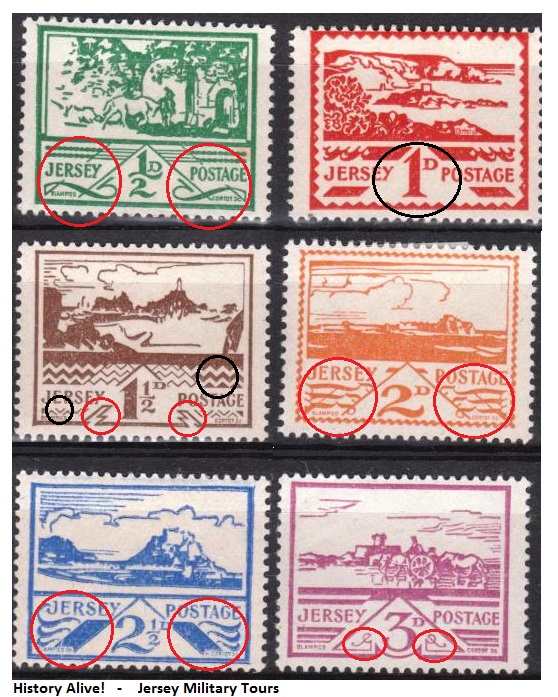I first explain that resistance could be one of three types:
- Armed resistance of the type already mentioned, whereby resistance groups waged a guerrilla war against the occupiers;
- Active resistance which is not in the first category, is generally non-violent, but is nonetheless deliberate and designed to harass, annoy or disrupt the occupying enemy; and
- Active resistance whereby assistance is given to the enemies of the occupying force.
As I have already said, there was no resistance of the first type in the Channel Islands. Because of the Islands’ small size, and the size of the German garrisons which were roughly half the population the Channel Islands, there was no scope to operate a guerrilla war. Unlike in occupied Europe, there are no large tracts of land in the Islands where resistance fighters could live in secret and then disappear into after an attack. In fact any remotely “wild” areas around the coast were likely to be occupied by the Germans as they constructed Hitler’s impregnable Atlantic Wall.
The second example of resistance took many forms. At one end of the scale, the local authorities who were responsible for the civil population, but who nonetheless had to implement German orders, did try and minimise the effect of superior orders when they could. Delay was occasionally possible, and protest sometimes received a sympathetic ear before the islands got more fervent Nazi officers later in the Occupation. However, it was limited what the civil authorities could do which led to many post-war allegations that they had collaborated with the Germans. I think that in the time that has passed since the Occupation, with the knowledge we now have, the actions of the civilian authorities of the Island have been vindicated.
On the street, the mildest form of resistance was to ignore the Germans if at all possible. Easier said than done in many cases! More active resistance could take the form of the dangerous but popular pastime of stealing German supplies, fuel, food and equipment to minor acts of “sabotage” to cause damage to German vehicles and equipment. Forced labourers working for the Germans sometimes deliberately made weak concrete when making anti-tank walls, and it was common for farmers to fail to register a new-born cow or pig as required by the German authorities, which meant that those animals did not enter the rationing system. Breaching the rules and regulations were severely punished by the Germans, and could easily result in a spell in the local prison, or worse still, if the sentence was longer than a few months, a spell in a French or German prison, or most feared, in a German concentration camp. Later in the Occupation, inciting German troops to mutiny once they had been cut off by the Allied advance after D-Day was also popular if not dangerous should the more hard-line Nazis amongst them become aware of it.
One of the things which pre-occupied the Germans most was to ensure that their news and propaganda was what the citizens of their occupied territories heard. So in the Channel Islands, many islanders deliberately ignored orders to hand in radios as required, hid them, even made crystal wireless sets to replace confiscated radios, and continued to listen to the BBC for news. Some set up networks or printing presses to disseminate the news other than that which the German censor passed. When the “V” for victory campaign was launched by the BBC as a rallying call to the resistance movements of Europe, Channel Islanders answered also the call.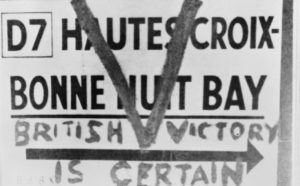
There were very many forms of this second type of resistance, and sometimes it was so subtle that even the Germans missed it, despite it being under their very noses. Certain things soon run out and disappear when a place is cut off without replacement supplies. In the occupied Channel Islands, British banknotes and coinage (Sterling could still be used at the official exchange rate to the Reichsmark) soon disappeared. The solution of the Island authorities was to issue small denomination notes to replace the coinage. In Jersey, the Sixpence note (6d, which would be worth 2 1/2p now, but then could have bought many everyday essentials) was designed by the local artist Edmund Blampied. Despite the design being approved by the Germans, when the note was folded in four and passed in payment for an item, a very prominent “V” was displayed. Arguably, folded the other way, you could display “G R” for George Rex (Photos are of an oversized replica)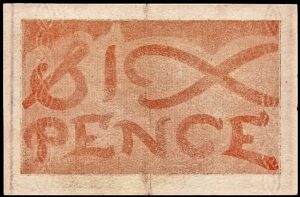
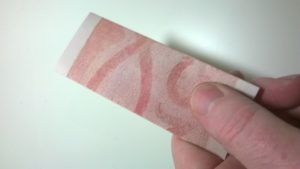
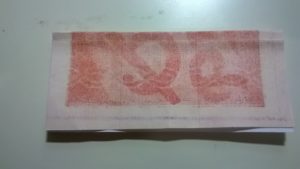 Edmund Blampied also designed a new set of stamps for Jersey when the stock of existing stamps ran out. These too were approved by the German authorities, notwithstanding that each of them had “Vs” in their designs (see the black circles on the photo). Even more surprising, and in a display of continuing loyalty to King George VI, each stamp has stylised “Gs” and “Rs” as an abbreviation for George Rex. The 3d stamp is quite clear when you know this fact, but each of the others have designs which are a little harder to see (see the red circles on the photo to help).
Edmund Blampied also designed a new set of stamps for Jersey when the stock of existing stamps ran out. These too were approved by the German authorities, notwithstanding that each of them had “Vs” in their designs (see the black circles on the photo). Even more surprising, and in a display of continuing loyalty to King George VI, each stamp has stylised “Gs” and “Rs” as an abbreviation for George Rex. The 3d stamp is quite clear when you know this fact, but each of the others have designs which are a little harder to see (see the red circles on the photo to help).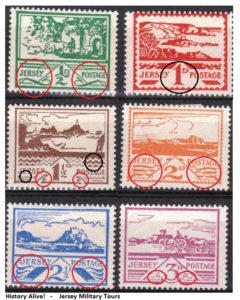
Perhaps Blampied was following the lead as before the pictorial set of stamps were issued, well known local historian Major NVL Rybot D.S.O., a veteran of the First World War and accomplished artist, added his own little message on the standard issue 1/2d and 1d stamps. The instructions from the Germans were that there was to be no head of George VI or other visual connection with Great Britain on the stamps. The shield design used was based on a medieval one of three leopards, which had used in both Jersey and Guernsey for hundreds of years. The design seemed to have sneaked passed the Guernsey authorities, notwithstanding that the leopards were the Plantagenets crest and part of the Royal Coat of Arms of Britain! Wanting to capitalise on the Germans’ approval of the Royal leopards, and taking a step further, Rybot added 2 “As” and 2 “Bs” in the corners of the 1/2d Jersey stamp based on the Guernsey design, and 4 “As” on the 1d stamp. They stood for “Atrocious Adolf” and “Bloody Benito” (Mussolini) and “Ad Avernum, Adolphe Atrox”: that is to say “To Hell with you, Atrocious Adolf”. These too were passed by the Germans for issue without them noticing the design detail messages.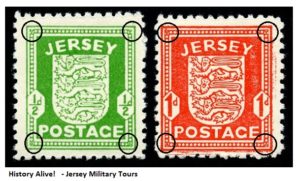
Getting back to the three types of resistance, examples of the third include assisting Allied servicemen, if they found themselves in occupied Channel Islands, either as a result of the misfortune (e.g. crash-landing) or by design (e.g. commando raids). Actual examples of these are quite few as there were only a handful a very small reconnaissance commando raids rather than full-blown assaults, and any airmen who did crash land were very quickly captured by the numerous Germans stationed all over the Islands. Another form of this resistance, and which has gained widespread recognition is the assistance given to Jews trapped in the Islands, and who otherwise were to be part of Hitler’s Final Solution, and also to the many mainly Russian prisoners of war, who were brought to the Channel Islands to work on German fortifications as slaves in an inhumane regime of neglect, brutality and death. How Islanders risked their lives hiding Jews and escaped slave workers is a story for a later instalment of this blog.

